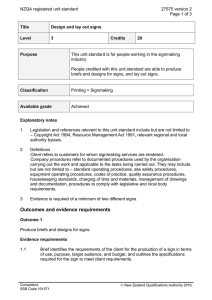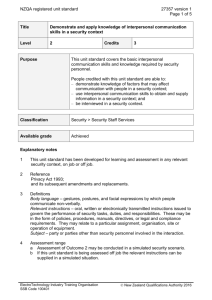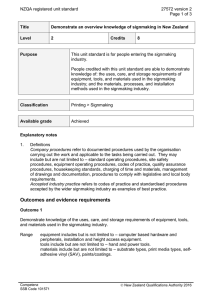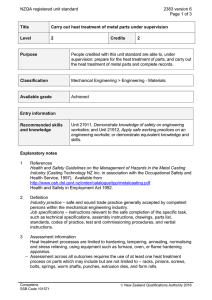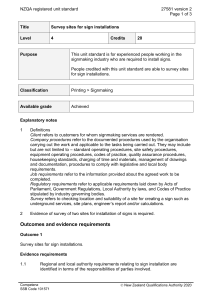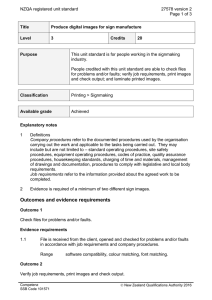NZQA registered unit standard 20722 version 2 Page 1 of 5
advertisement
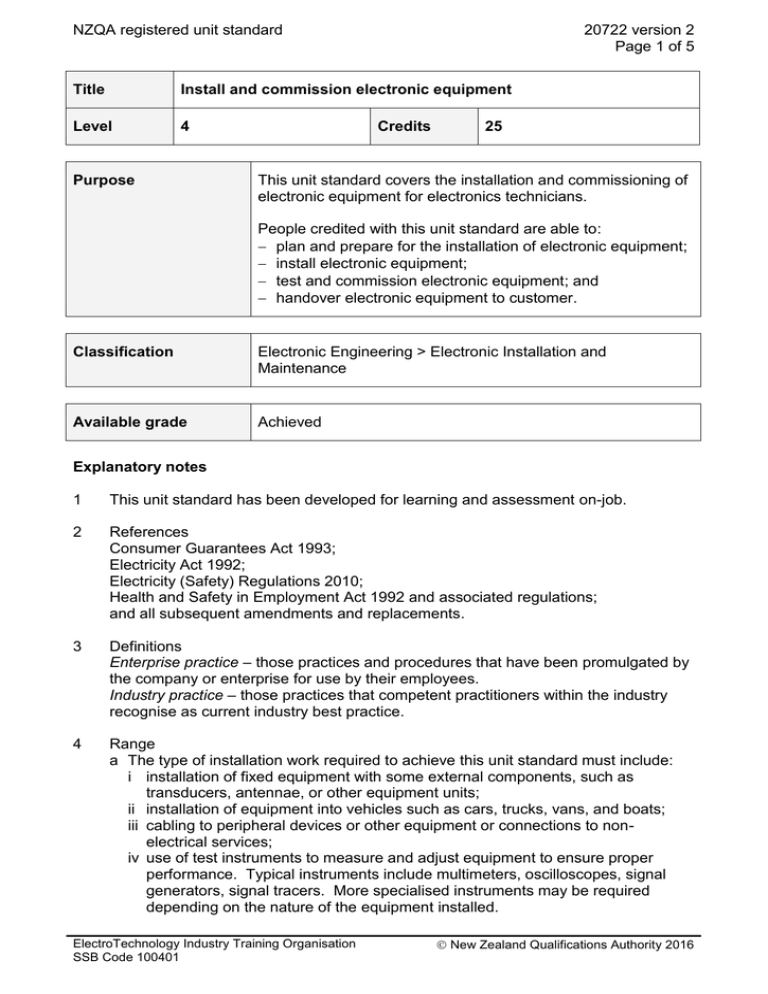
NZQA registered unit standard 20722 version 2 Page 1 of 5 Title Install and commission electronic equipment Level 4 Purpose Credits 25 This unit standard covers the installation and commissioning of electronic equipment for electronics technicians. People credited with this unit standard are able to: plan and prepare for the installation of electronic equipment; install electronic equipment; test and commission electronic equipment; and handover electronic equipment to customer. Classification Electronic Engineering > Electronic Installation and Maintenance Available grade Achieved Explanatory notes 1 This unit standard has been developed for learning and assessment on-job. 2 References Consumer Guarantees Act 1993; Electricity Act 1992; Electricity (Safety) Regulations 2010; Health and Safety in Employment Act 1992 and associated regulations; and all subsequent amendments and replacements. 3 Definitions Enterprise practice – those practices and procedures that have been promulgated by the company or enterprise for use by their employees. Industry practice – those practices that competent practitioners within the industry recognise as current industry best practice. 4 Range a The type of installation work required to achieve this unit standard must include: i installation of fixed equipment with some external components, such as transducers, antennae, or other equipment units; ii installation of equipment into vehicles such as cars, trucks, vans, and boats; iii cabling to peripheral devices or other equipment or connections to nonelectrical services; iv use of test instruments to measure and adjust equipment to ensure proper performance. Typical instruments include multimeters, oscilloscopes, signal generators, signal tracers. More specialised instruments may be required depending on the nature of the equipment installed. ElectroTechnology Industry Training Organisation SSB Code 100401 New Zealand Qualifications Authority 2016 NZQA registered unit standard 20722 version 2 Page 2 of 5 b Candidates are expected to meet the outcomes of this unit standard without direct technical supervision, and with complete responsibility for quality and quantity of output. c Electrical, radiation, and workshop or laboratory safety practices are to be observed at all times. d All activities and evidence presented for all outcomes and evidence requirements in this unit standard must be in accordance with legislation, policies, procedures, ethical codes, Standards, applicable site and enterprise practice, and industry practice; and, where appropriate, manufacturers’ instructions, specifications, and data sheets. e Evidence is required of at least 10 different installations and commissioning. The number and type of equipment chosen are left to the discretion of the assessor, but must be sufficient to assess competence in all outcomes of the unit standard. 5 For the purpose of this unit standard, industry practice requires that: a equipment is installed in accordance with the manufacturers' instructions, specifications, and standards; b the electronic equipment installation is protected against mechanical and electrical failure in normal service and from any abnormal conditions that may be reasonably anticipated; c all fixings, fastenings, and supports are of adequate strength; d the characteristics of the electronic equipment are not impaired in the process of installation, testing, and commissioning; e all material immediately adjacent to or in contact with leads, cables, or feeders is shaped so that it will not cause abrasion of leads, insulation, braiding, or sheathing that could lead to mechanical or electrical failure; and f all connections to leads, cables, feeders, and/or equipment are made in a way that ensures safe and reliable contact. Outcomes and evidence requirements Outcome 1 Plan and prepare for the installation of electronic equipment. Evidence requirements 1.1 Evaluation of job contract, job specification, time-lines, and discussion with the customer establish the scope and timing of the installation work. 1.2 Orderly progress of the installation is planned and agreed with the customer. Range typical considerations – available resources, required materials, timing, relevant authorities, electric power, standards and quality processes, compatibility with existing and possible future systems, site access, job contract, specifications. 1.3 All site occupational safety and health implications for self and others are identified, and hazard control measures are put in place. 1.4 Materials are purchased or drawn from stock, and delivery to the site is confirmed in accordance with enterprise practice. ElectroTechnology Industry Training Organisation SSB Code 100401 New Zealand Qualifications Authority 2016 NZQA registered unit standard 20722 version 2 Page 3 of 5 Outcome 2 Install electronic equipment. Evidence requirements 2.1 The location, positioning, mounting, and fitting of installation hardware are in accordance with industry practice. 2.2 Leads, or cabling, or feeders are installed in accordance with specifications and industry practice. 2.3 Electronic equipment is positioned, terminated, configured, and designated in accordance with industry practice. 2.4 Installation progress reports are maintained in accordance with enterprise practice and/or customer requirements. 2.5 Drawings and documents are marked up to represent the as-built state. 2.6 Site is restored in accordance with customer’s expectations following the completion of installation. Outcome 3 Test and commission electronic equipment. Evidence requirements 3.1 Inspection confirms that all specified items have been installed in accordance with industry practice. 3.2 Tests and adjustments of all component parts are completed in accordance with industry practice. 3.3 Commissioning tests confirm that the complete installation operates in accordance with the specifications. 3.4 Results are recorded in accordance with specifications and customer requirements and/or enterprise practice. Outcome 4 Handover electronic equipment to customer. Evidence requirements 4.1 The electronic equipment is made available to the customer by the agreed date. 4.2 The equipment operation is communicated to the customer in accordance with the equipment manual and the Consumers Guarantees Act 1993. ElectroTechnology Industry Training Organisation SSB Code 100401 New Zealand Qualifications Authority 2016 NZQA registered unit standard 20722 version 2 Page 4 of 5 4.3 The warranty and service options are communicated to the customer in accordance with the equipment manual and the Consumers Guarantees Act 1993. 4.4 Support materials are supplied to customer in accordance with contract and enterprise practice. typical support materials – drawings, performance certification, test results, operation and maintenance materials, product leaflets and instructions, testing instructions, troubleshooting guides. Range 4.5 Handover documentation is completed in the agreed format, in accordance with customer requirements and/or enterprise practice. Planned review date 31 December 2016 Status information and last date for assessment for superseded versions Process Version Date Last Date for Assessment Registration 1 26 July 2004 31 December 2012 Review 2 21 July 2011 N/A Consent and Moderation Requirements (CMR) reference 0003 This CMR can be accessed at http://www.nzqa.govt.nz/framework/search/index.do. Please note Providers must be granted consent to assess against standards (accredited) by NZQA, before they can report credits from assessment against unit standards or deliver courses of study leading to that assessment. Industry Training Organisations must be granted consent to assess against standards by NZQA before they can register credits from assessment against unit standards. Providers and Industry Training Organisations, which have been granted consent and which are assessing against unit standards must engage with the moderation system that applies to those standards. Requirements for consent to assess and an outline of the moderation system that applies to this standard are outlined in the Consent and Moderation Requirements (CMRs). The CMR also includes useful information about special requirements for organisations wishing to develop education and training programmes, such as minimum qualifications for tutors and assessors, and special resource requirements. ElectroTechnology Industry Training Organisation SSB Code 100401 New Zealand Qualifications Authority 2016 NZQA registered unit standard 20722 version 2 Page 5 of 5 Comments on this unit standard Please contact the ElectroTechnology Industry Training Organisation reviewcomments@etito.co.nz if you wish to suggest changes to the content of this unit standard. ElectroTechnology Industry Training Organisation SSB Code 100401 New Zealand Qualifications Authority 2016
